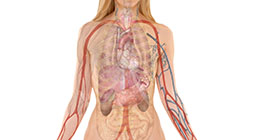
Overview
Symptoms
Causes
Prescription
Health Tips
Anemia is a condition where the number of red blood cells, or the amount of hemoglobin they carry, is low. A reduction in either hinders the body’s ability to transfer oxygen to the lungs and other areas of the body. Anemia can be easily determined by a simple blood test. There are several types of anemia.
Iron Deficiency Anemia
The most common form is iron deficiency anemia. Iron is needed to produce hemoglobin (found in red blood cells), but when excessive bleeding occurs red blood cells and the necessary iron are lost. Although iron is recycled to make new red blood cells, when excess bleeding has occurred there is not enough iron to rebuild red blood cells in the bone marrow. Additionally, if one’s diet is very low in iron, iron deficiency can occur.
Supplements are used with success to correct iron deficiency anemia. While anyone can develop anemia, it is more common in women due to menstruation and pregnancy. Males who are athletes, vegetarians or vegans, or have certain health conditions are at risk. While the reasons are unknown, women of African-American or Hispanic decent are more likely than Caucasian women to suffer from anemia.
Low iron does not develop overnight. The human body anticipates this problem and stores iron (as ferritin) in case future dietary intake is inadequate. But over time, if needs aren’t met these stores will deplete in the following ways:
- Iron Depletion: At first, the body uses whatever stored iron it has to keep levels of hemoglobin normal. At this stage of iron depletion, there may be no symptoms.
- Iron Deficiency: Gradually, hemoglobin levels drop below normal, oxygen supplied to cells diminishes and symptoms may begin, particularly tiredness.
- Iron Deficiency Anemia: Over time, hemoglobin and ferritin levels become so low that the blood cannot deliver enough oxygen to cells. Symptoms like paleness, breathing difficulties, low immunity, lack of mental clarity and greater fatigue are common.
Vitamin Deficiency Anemia
Vitamin deficiency anemia occurs when vitamin B12, folic acid or vitamin C levels are too low. These nutrients are used by the bone marrow to make red blood cells.
Pernicious Anemia
Pernicious anemia, a form of vitamin deficient anemia, is associated with autoimmune disease. It develops at the last stage of autoimmune gastritis due to the immune system destroying the gastric mucosal lining. It also develops from autoimmune hemolytic anemia, a condition where red blood cells are attacked and destroyed. In this state of anemia, the body is unable to use vitamin B12 and as a result, digestion is compromised, as is the body’s ability to produce red blood cells. Ten to fifteen percent of those with autoimmune gastritis have pernicious anemia. Two percent of the Western population over 60 years of age is deficient in vitamin B12 and has pernicious anemia. Pernicious anemia can easily be treated with vitamin B12.
Symptoms
Symptoms may start to appear before a person is clinically anemic.
Signs of iron deficiency anemia are:
- Abdominal discomfort
- Chest pains
- Cracks at the sides of the mouth
- Cravings for dirt and ice
- Dizziness
- Fatigue
- Hair loss
- Inability to exercise even moderately
- Infertility
- Pale skin or appearance
- Pregnancy complications
- Rapid heartbeat
- Restless legs and leg cramps
- Shortness of breath
- Spoon-like fingernails
Symptoms of Vitamin B12 deficiency:
- Mental confusion
- Muscle weakness
- Numbness and tingling in hands or feet
Causes
Iron Deficiency Anemia
Iron deficiency anemia often occurs when the body is losing iron faster than it can be replaced. Regularly giving blood, physical injuries, surgery and chronic bleeding disorders can all cause anemia. People eating a diet lacking in sufficient amounts of iron, or vegetarians, vegans, chronic dieters, anorexics, and bulimics are all at an increased risk for low iron or iron deficiency anemia.
As mentioned, women are at a much greater risk of developing anemia due to menstruation. The average woman losses around 40 mg of iron during her period. The amount is higher for women with heavy periods. Many women, especially vegetarians and vegans, do not consume enough iron to make up for the loss that occurs each month.
Infants and toddlers who drink too much milk are at a greater risk of developing anemia, this is because calcium hinders iron absorption.
At certain times the body’s need for iron increases, including during growth spurts, periods of increased physical activity or exercise, pregnancy and breastfeeding. A deficiency can occur quickly during these times of heightened need. Lastly, some people, including the elderly and people with digestive issues and/or disease, have a reduced ability to absorb or use iron from food.
Crohn’s disease and ulcerative colitis (IBD disorders) sufferers are at a very high risk of low iron and anemia. Up to 80 percent of people with IBD will have low iron and around 1/3 fall into the anemic range. IBD disorders can cause bleeding in the digestive tract, and in addition, inflammation in the digestive system hinders iron absorption.
Vitamin Deficiency Anemia
In addition to the above, those with Crohn’s disease are also at an increased risk of vitamin deficiency anemia. Inflammation in or loss of the small intestine reduces absorption of folate and vitamin B12.
Other factors that may cause vitamin deficiency anemia:
- A strict vegetarian or vegan diet
- Celiac sprue or wheat/gluten intolerance
- Gastric surgery
- Leaky gut
- Malabsorption syndrome
- Poor nutrition
Pernicious Anemia
The cause of pernicious anemia is not known, but two factors are known to contribute. Firstly, there is a genetic inheritance, and it coexists with other autoimmune disorders, such as Hashimoto’s thyroiditis, Graves’ disease, primary Addison’s disease, type 1 diabetes, vitiligo, myasthenia gravis, premature graying, and primary ovarian failure. Secondly, a lack of ‘intrinsic factor’ needed to absorb B12 is often the cause of pernicious anemia. Intrinsic factor is released by the stomach cells which, if damaged by disease may inhibit its release; or intrinsic factor is not released due to low HCl and the pancreatic enzyme trypsin.
Important Iron Blood Tests
Low iron status is common—and is just as commonly overlooked. Have serum ferritin checked by a doctor. The body stores iron as ferritin. Knowing what levels are at is a good indicator of whether iron is low or suffering from a deficiency. A blood test that checks hemoglobin levels will only catch the problem once iron stores are close to depleted. Testing hemoglobin alone does not give enough information. It is important to see test result. Many doctors will say levels are good when they are actually low enough to cause symptoms. For example many women start to lose hair at 40 ug/L, which is well within the range some doctors consider normal.
Hemoglobin – The test range is 117-160 g/L for women and 131-180 g/L for men. 140 g/L is best.
Ferritin – The test range is 15-160 ug/L for women and 15-410 ug/L for men. Around 100 ug/L is ideal.
Prescription for Health
Attaining the reccomended daily allowence (RDA) for iron, vitamin B12, or folate through food alone is not enough to correct anemia. Both diet and supplementation are very important when trying to address iron deficiency. In addition to increasing iron intake through food, people with anemia will need an additional 150 to 200 mg of elemental iron daily. If diet adjustments and iron supplementation do not increase iron levels, it is important to rule out internal bleeding in the digestive tract. People with IBD may need iron injections in order to increase levels.
| Nutrient | Dosage | Action |
|---|---|---|
| BioFe® Iron (Micronized, Microencapsulated Iron Pyrophosphate III) | 10–30 mg of elemental iron | Does not constipate, enhances iron |
| BeRegular® Prebiotic Fiber and Probiotic Blend | One scoop – 6 grams Guar fiber – 5 grams Bifidobacterium lactis – 8 billion CFUs | Clinically researched ingredients to improve absorption |
| Probiotic Bifidobacterium longum (100% BB536) | Five to 10 billion active cells | Clinically researched to improve absorption |
| Digestive Enzymes | 1–2 capsules with meals | Maximizes digestion |
| Vitamin B12 for pernicious anemia | Injection 1 mg weekly for six weeks or until anemia is reversed, then once monthly. Those with pernicious anemia need B12 for life. Oral methylcobalamin, the active form of B12 in sublingual tablets 2000 mcg daily until anemia is reversed and 1000 mcg thereafter. | Essential for blood cell formation |
Health Tips to Enhance Healing
- Avoid alcohol, coffee, tobacco, birth control pills, and topical steroids; these inhibit vitamin B12 absorption.
- Avoid giving infants and young children cow’s milk, especially at mealtime.
- Cook spinach as iron absorption is hindered when eaten raw.
- Eat high calcium foods separately from high iron foods.
- Eat organic calf’s liver or chicken liver.
- For low stomach acid, try hydrochloric acid.
- If ferritin is not rising with supplementation and diet changes, have internal bleeding ruled out. For example, bleeding ulcers.
- Include plenty of dark green leafy vegetables in diet.
- Proper digestion is important. Do not stand at the sink or eat on the run. Sit down in a relaxing atmosphere. Eat slowly, chew often, and do not drink fluids while eating.
- Take digestive enzymes before a meal. Drinking fluids while eating dilutes digestive enzymes and should be avoided.
- Treat heavy periods aggressively.
- Uterine Fibroids and adenomyosis are a common cause of abnormal menstrual bleeding in women, which can contribute to anemia due to increased blood loss.










